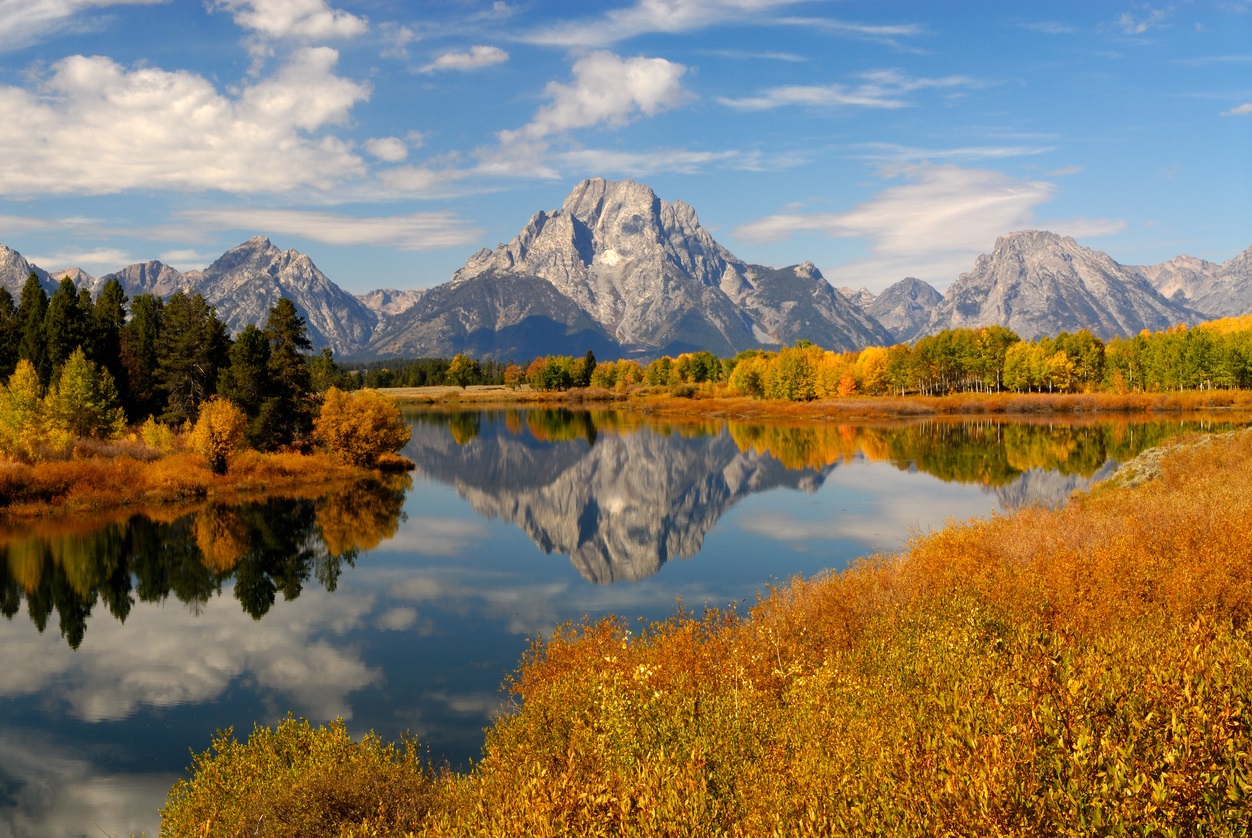Breathe in the crisp fall air and explore the expansive outdoors among the changing colors of leaves by adding these national parks to your autumn travel list. The sheer size of the U.S. national park sites (NPS) with diverse landscapes makes deciding when and where to go feel daunting. While many national parks are perfect to visit during any season, Winetraveler narrowed down 10 of the best national parks to visit in the autumn. Naturally, many of these parks were selected to witness spectacular foliage.
You can view current flight deals here and hotel options here for any of the destinations we mention below.
- Acadia National Park, Maine
- Shenandoah National Park, Virginia
- Great Smoky Mountains National Park, Tennessee & North Carolina
- Cuyahoga Valley National Park, Ohio
- Theodore Roosevelt National Park, North Dakota
- Badlands National Park, South Dakota
- Wind Cave National Park, South Dakota
- Grand Teton National Park, Wyoming
- Glacier National Park, Montana
- Mammoth Cave National Park, Kentucky
Winetraveler Note: For the parks selected to witness fall foliage, Winetraveler includes the “general” peak time to witness the fall foliage, but it’s just that, “general.” Each year, the optimal time may vary depending on weather conditions.
RELATED: 10 Top US National Parks to Visit during the Winter
Acadia National Park, Maine
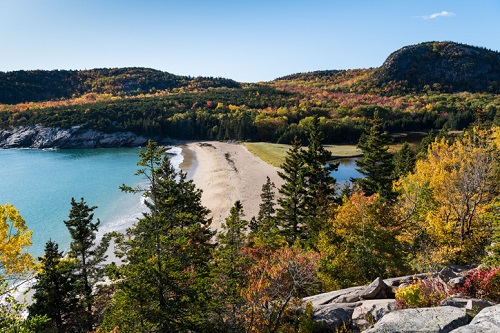
Acadia National Park, described as the “Crown Jewel of the North Atlantic Coast” is home to the tallest mountain on the U.S. Atlantic Coast. It draws many travelers year-round, but the peak season is typically from July through August. The crowd starts to dissipate post-Labor Day, but then the park tends to get more crowded as tourists flock to see the autumn leaves from late September until mid-October. If you’re planning a trip to see the beautiful fall colors, plan to get an early start to beat the crowd.
Stargazing, birdwatching, hiking, and driving the 27-mile Park Loop Road are favorites here. The park has over 150 miles of hiking trails and 45 miles of carriage roads. The hiking trails offer stunning contrasts from immense forests, rocky coastlines, and mountain tops. Popular hikes to consider include Cadillac Mountain, Bar Island Trail, Wonderland Trail, Ocean Path, Jordan Pond, Acadia Mountain Loop, Precipice Trail, and Beech Cliff Ladder Trail. Classic places to see include Otter Cliff, Thunder Hole, and Sand Beach.
Shenandoah National Park, Virginia
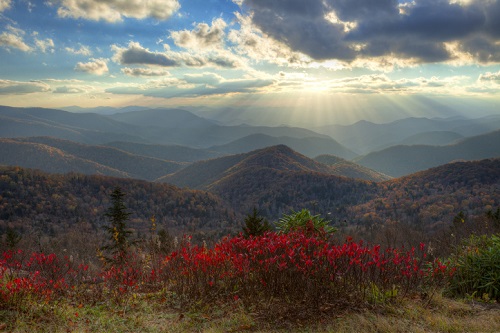
Shenandoah National Park, spanning over 200,000 acres of protected land, features cascading waterfalls, exquisite viewpoints, wooded hollows, spacious meadows, and over 500 miles of hiking trails. It shines all year round through the different seasons, but if you’re searching for a prime spot to witness a vibrant display of fall foliage, October is generally the peak time to visit for this purpose. Being only ~75 miles from Washington, D.C., it is a convenient park to visit for a long weekend getaway.
Drive along the scenic Skyline Drive. Get your hiking shoes and head out to explore the great outdoors. Search for the hikes that best suit your style directly on the NPS website. The NPS separated hikes by location, distance, to waterfalls, for kids, for birdwatchers, to Old Rag, and even the best hikes to avoid crowds. Popular hikes to consider include the 1-mile roundtrip hike to Little Stony Man Overlook that follows a section of the Appalachian Trail and the ~9.4-mile circuit hike to Old Rag Trail classified as very strenuous.
Of course, while you’re in Shenandoah, make time to uncork Virginia’s wine country and try ten great Virginia wineries.
Great Smoky Mountains National Park, Tennessee & North Carolina
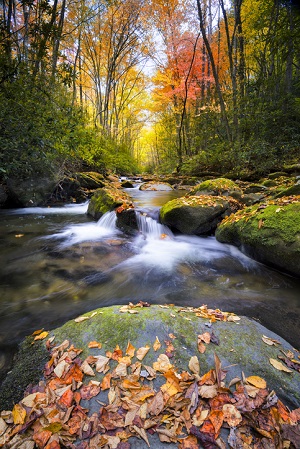
No matter the season, the Great Smoky Mountains National Park, named for the frequent blue-gray haze floating over the mountain ridges, is a perfect destination for nature-inspired wine lovers. Winetraveler included it on the autumn list because of the fall foliage. The best time to experience the fall colors here is generally from mid-October to early November. The park was established in 1934, spans an area of more than 522,000 acres, and is situated almost evenly within the states of Tennessee and North Carolina. There are nearly endless possibilities to keep all traveling style personalities of any age busy. Explore hiking trails, nearby towns, and museums. Go horseback riding, zip-lining, river tubing, fly fishing (with a license), rafting, paddle boarding, canoeing, or kayaking. While in the Smoky Mountains, taste local, and experience the Rocky Top Wine Trail with visits to the following wineries: Apple Barn Winery; Hillside Winery; Mountain Valley Winery; Mill Bridge Winery; and Sugarland Cellars.
There are numerous lovely places to stay to base your Smoky Mountains getaway. Retreat to a private cabin in the upscale Grandview Resort in Sevierville, stay in a treehouse in Gatlinburg at Treehouse Grove, or stay at the Westgate Smoky Mountain Resort & Water Park.
RELATED: Smoky Mountains Itinerary & Travel Guide: Beautiful Cabin Retreat
Cuyahoga Valley National Park, Ohio
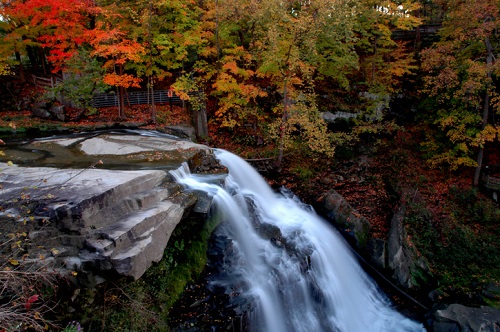
Venture to Cuyahoga Valley National Park mid-to-late October to experience colorful autumn foliage at its peak. The park is conveniently located ~30 minutes from Cleveland, Ohio. Outdoor adventurers can stay active with hiking, biking, fishing, horseback riding, and canoeing/kayaking down the Cuyahoga River (for those with equipment). Popular hiking trails include Brandywine, Ohio & Erie Towpath, and the Ledges.
Explore the beauty of the national park via a scenic train ride aboard the Cuyahoga Valley Scenic Railroad (train rides plan to resume May 1). On Friday nights, the train hosts dinner and entertainment events. Special events to check for include: a Grape Escape featuring a wine tasting, a Murder Mystery event, and Ales on Rails to sample beers. Click here for more information and to book your tickets.
Theodore Roosevelt National Park, North Dakota
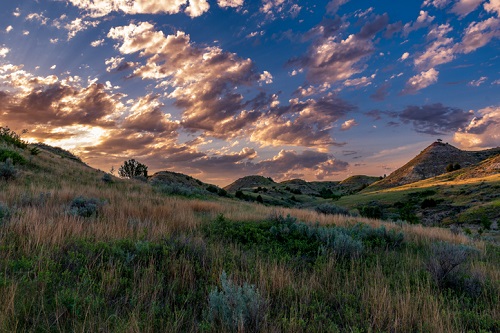
Visit Theodore Roosevelt National Park in the early fall and discover why Theodore Roosevelt fell in love with North Dakota. The rolling grasslands, jagged canyons, buttes, open plains, and multi-colored badlands in all directions appear endless. Summer tends to be the park’s most congested season. Sprinkled with patches of fall colors contemporaneously with fewer crowds makes autumn an excellent time to experience this awe-inspiring unsettled wilderness. Mid-to-late October is generally the peak time to see the fall foliage. This rugged landscape inspired Theodore Roosevelt to focus his policies on conservation after becoming America’s 26th president.
While the park is fairly remote, it’s an easy park to visit once you’re there, even if you spend no time charting out what you want to do ahead of time. Driving along the winding scenic path through the park while stopping at many lookout spots is fabulous. Drive carefully as wildlife is abundant. Herds of bison, wild horses, bighorn sheep, elk, deer, countless prairie dogs, and many more animals make their home here. Pack a picnic basket, pick your favorite overlook spot, and have a picnic while soaking in views capable of taking your breath away.
Plentiful hiking trails from easy to strenuous levels await and are listed and described on the park’s website. Biking, horseback riding, and fishing (with a license) are all possible.
RELATED: Midwest & Dakotas Road Trip Itinerary: Colorado, Wyoming, Nebraska, South and North Dakota
Badlands National Park, South Dakota
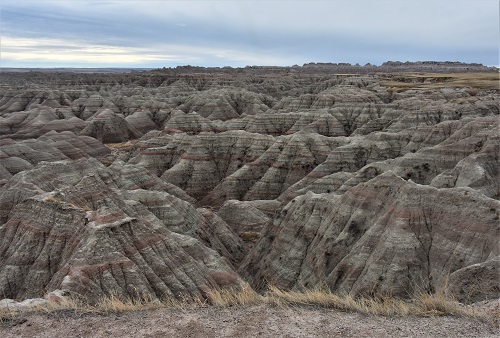
The Badlands generally gets quite crowded in the summer months. Avoid the crowd by planning your trip here in the early fall before it gets really cold. Badlands National Park, spanning 244,000 acres, is home to semi-desert scenery, grasslands, multi-colored layered rock formations, valleys, steep canyons, and plentiful wildlife. The Badlands formed by soft sedimentary rock being eroded by the dry climate. Numerous bison, deer, and antelope graze. Prairie dogs scurry in and out of their underground holes, seemingly by the thousands. You may even see a herd of bighorn sheep and rams.
As you make the 31-mile loop along the Badlands Loop State Scenic Byway, there are plenty of overlooks and trails to choose from to stretch your legs and be closer to the natural rugged beauty. Driving along the winding roads is remarkable. Each stone structure is unique. The surrounding barren plains make the incredible buttes, cliffs, and multi-colored spires appear even more impressive.
Hiking, biking, and horseback riding will keep outdoorsy spirits engaged. Admire the change in colors of the rock formations by catching it during sunrise and sunset. Make sure to look up in the sky to admire the starry nights. Check all things to do on the park’s website here.
Wind Cave National Park, South Dakota
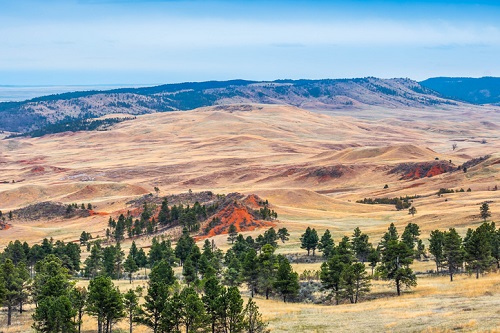
With summer generally being the most popular time to visit Wind Cave National Park, this is one of the reasons Winetraveler selected it as part of its autumn list. Visit during the early fall and enjoy the wilderness with smaller crowds. At Wind Cave National Park in South Dakota, countless wildlife roams the expansive 28,000 acres of scattered hills. Bison, deer, and elk are plentiful. The prairie dogs are so numerous, in some areas, it looks like the earth is moving as they scurry around. Be on the lookout for badgers. Enjoy the scenic drive of the beautiful terrain and pick the hiking trails that most interest you.
Below this extraordinary land is a vast cave. Tours of the cave range from 1 hour to 90 minutes and involve walking up and down quite a few stairs. The cave tours are presently suspended due to COVID-19, but check back on the park’s website because the cave access may resume by the time of your trip.
Grand Teton National Park, Wyoming
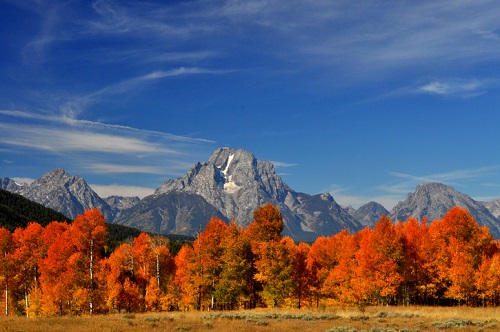
Breathe in the crisp mountain air with a fall trip to Grand Teton National Park. The park, with its dramatic peaks, breathtaking alpine scenery, rugged wilderness, and abundant wildlife, is a year-round wonderland. In the fall, experience the park when the crowds have dispersed while being captivated by the wondrous fall colors. Early to mid-October is generally the optimal time for a fall visit here. The park is packed with outdoor activities for adventurers, including more than 200 miles of hiking trails at a range of levels, bike trails, wildlife tours, and guided raft trips down Snake River. The daunting peaks offer many strenuous hikes for hikers inclined for a challenge.
RELATED: Winter Itinerary: Big Sky, Jackson Hole & Yellowstone National Park
Glacier National Park, Montana
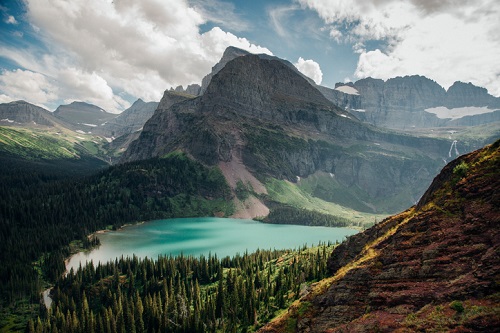
Towering mountains, 734 miles of hiking trails, alpine lakes, immense wildlife, sleeping under the stars, biking, fishing, and boating are just some of what makes Glacier Lake National Park a dream destination. Fall is an incredible time to visit. The peak time for fall foliage is typically the first half of October. Wildlife viewing tends to be supreme since the wild animals are often active as they prepare for the long winter ahead. The park is less crowded, and thus so are the hiking trails, which also corresponds for hikers to be on the heightened lookout for animal encounters. The NPS recommends hikers carry bear spray. Advanced planning is required this time of year as there are closures within the park, including roads and visitor centers.
Mammoth Cave National Park, Kentucky
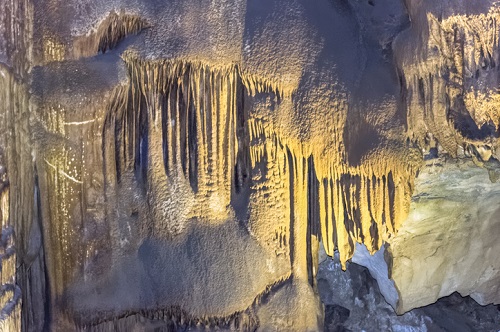
While most are familiar with the underground attractions at Mammoth Cave National Park, the world’s largest known cave system, Kentucky is an excellent place to soak in the fall colors. The thick woodlands above this extensive cave system radiate vibrant colors in autumn. The best time to see the colors is generally from early-to-mid-October. Outside of the cave, the park features rolling hills, deep river valleys, over 80 miles of hiking trails, canoeing, kayaking, boating, horseback riding, and bicycling.
RELATED: Red River Gorge Kentucky Itinerary: Private Cabin Retreat
